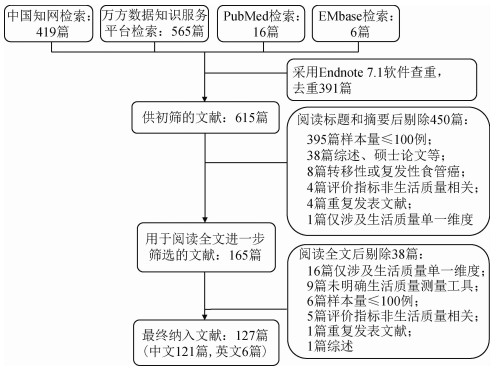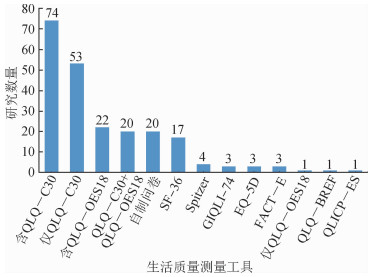文章信息
- 朱娟, 马山蕊, 李新庆, 魏文强.
- Zhu Juan, Ma Shanrui, Li Xinqing, Wei Wenqiang
- 中国食管癌患者生活质量研究系统综述
- A systematic review on quality of life of esophageal cancer patients in China
- 中华流行病学杂志, 2020, 41(9): 1536-1541
- Chinese Journal of Epidemiology, 2020, 41(9): 1536-1541
- http://dx.doi.org/10.3760/cma.j.cn112338-20191104-00782
-
文章历史
收稿日期: 2019-11-04
食管癌是我国常见的恶性肿瘤之一,对居民生命健康危害极大。根据全球肿瘤流行病学统计数据2018报道,我国食管癌发病率和死亡率均占全球50%以上[1]。最新发布的肿瘤登记数据显示,2015年我国食管癌发病率和死亡率分别为17.9/10万(第6位)和13.68/10万(第4位)[2]。随着生物-心理-社会医学模式的转变,恶性肿瘤造成的躯体和心理的双重负担使得医学评价指标不再局限于死亡率和生存率,生活质量逐渐被作为评价临床疗效和疾病预后的重要指标[3-8]。生活质量(quality of life)亦称生命质量、生存质量,是个体躯体、心理和社会完好状态的多维度综合指标。由于恶性肿瘤较难治愈且不易延长生存年限等特点,癌症患者的生活质量研究已成为研究热点[9]。量表测定是癌症生活质量评估的主要手段,包括通用性量表和癌症特异性量表[10]。本系统综述拟了解我国食管癌生活质量评价研究开展的整体概括、具体涉及量表及相关评价结果,为将来进一步研究食管癌生活质量提供方向及方法学参考。
1、资料与方法1.文献检索:计算机系统检索中国知网、万方数据知识服务平台、PubMed和EMbase数据库,搜集国内外公开发表的中国食管癌患者生活质量相关研究,检索时限为2009年1月1日至2019年8月1日。采用主题词与自由词相结合的检索方式。中文检索词为(生存质量+生活质量+生命质量)和(食管癌+食道癌+食道肿瘤+食管肿瘤),PubMed数据库检索式为Esophageal Neoplasms[MeSH Terms] AND Quality of Life[MeSH Terms] AND(China or Chinese)。
2.纳入与排除标准:纳入标准:①研究对象为明确诊断的原发性食管癌患者;②我国原创性生活质量评价研究;③评价指标涉及生活质量评价的多个维度。排除标准:①研究对象为转移性或复发性食管癌患者;②未明确评价量表;③评价指标非生活质量相关,如临床体征、毒副反应发生率和生存率等;④评价量表仅涉及生理、心理或社会等单一维度,如Karnofsky功能状态量表、焦虑自评量表和抑郁自评量表;⑤综述、述评、会议摘要及硕士论文研究;⑥样本量≤100例;⑦重复发表文献。
3.文献筛选和资料提取:由2名研究人员按照预先制定的摘录信息表独立提取数据,并交叉核对,如遇分歧则讨论决定。主要从以下几个方面进行数据摘录和分析:①基于文献计量的研究概括发表时间、研究地区、研究设计、样本量和评价内容等;②概括纳入文献涉及的食管癌生活质量评价量表,包括所有纳入研究中的量表使用频数及量表属性(类型、维度和条目)等;③汇总所有食管癌健康效用值评价结果。
2、结果1.一般情况:中国知网、万方数据知识服务平台、PubMed和EMbase初检分别获得419、565、16和6篇,去重后获得615篇文献;按照指定的纳入排除标准,通过阅读题目和摘要初筛剔除450篇,用于阅读全文复筛的文献有165篇,复筛剔除38篇,最终纳入文献127篇(中文121篇,英文6篇)(图 1)。

|
| 图 1 2009-2019年相关文献检索流程 |
2.基于文献计量的研究开展概况:共纳入食管癌生活质量评价研究127项,一半以上(79项)发表于2015年及以后。涉及全国26个省(自治区、直辖市),以河南省最多(21项),该地区研究主要依托于林州等食管癌高发区,其次是江苏省(18项),仅4项多中心研究。超过1/2(72项)研究样本量<150例。纳入研究关注医疗护理干预领域最多(58项),其次是治疗方案或药物效果评价(40项),涉及量表制定和信效度等方法学层面研究较少(2项),15项研究评估单纯食管癌患者生活质量,12项研究探究食管癌患者生活质量相关影响因素,结果发现:人口社会学因素、临床症状及体征、治疗方案、术后生存时间及心理环境因素等都对食管癌患者生活质量有影响,其中最主要因素为精神状况和消化道并发症(图 2)。

|
| 图 2 纳入研究基本情况概括 |
3.研究涉及的生活质量评价量表介绍:文献共涉及6种特异性量表[11-15]和4种通用性量表[16-17]。最常用的特异性量表为欧洲癌症研究治疗组织(European Organization for Research and Treatment of Cancer)开发的生活质量核心调查问卷(Core Quality of Life Questionnaire,QLQ-C30),共74项研究采用该量表[11];通用性量表最常用的为美国波士顿健康教育研究所开发的健康相关生命质量量表(36-item Short Form Health Survey,SF-36),纳入研究中有17项研究采用SF-36[16](图 3)。几乎所有量表均有关注躯体、生理和社会关系维度,不同量表设计的维度数量范围为2~15,设计的条目数量范围为5~74。食管癌生活质量评价相关量表见表 1。

|
| 图 3 纳入研究生活质量评价量表汇总 |
4.食管癌健康效用值:共2项研究转化为食管癌健康效用值数据[18-19],均采用欧洲五维度健康量表(EuroQoL Five-dimensional Questionnaire,EQ-5D)评估对食管癌患者生活质量,并按照中国特异性积分体系转化为健康效用值[20]。程萱等[18]研究得出食管癌及癌前病变人群健康效用值P50(P25~P75)为0.869(0.770~1.000),自评健康得分为80.00(70.00~90.00)分,不同临床分期和治疗方案的健康效用值差异均有统计学意义(P<0.01),癌前病变患者健康效用值明显高于癌症患者。Liu等[19]发现食管癌健康效用值为0.81±0.24,自评健康得分为(72.22±18.41)分,健康效用值随着食管病理级别恶化逐渐降低,食管癌前病变、食管癌Ⅰ、Ⅱ、Ⅲ和Ⅳ期患者健康效用值分别为0.90±0.16、0.82±0.23、0.81±0.24、0.80±0.24和0.66±0.34,低于正常对照组健康效用值(0.96±0.09)(表 2)。
5.提高食管癌生活质量措施:汇总纳入研究中常见的提高食管癌生活质量的手段,主要概括为①健康教育;②心理干预;③饮食营养干预;④院外延续护理干预。
3、讨论本研究对中国近10年食管癌生活质量评价研究系统回顾分析,发现我国食管癌生活质量研究数量增长较快。纳入研究整体存在以下特点:①多为单中心、横断面或临床试验的小样本研究;②评价量表以欧洲癌症研究治疗组织QLQ-C30应用最为广泛;③更多是应用型研究,针对基于我国本土人群和癌症患者的量表信效度评价较少,且未见以生活质量为指标的食管癌筛查干预效果评价的相关研究;④健康效用值数据仍匮乏,为后续食管癌卫生经济学评价贡献参数相对有限(如成本效用指标)。
我国食管癌生活质量研究评价量表多样,包括国外团队开发汉化量表和国内学者自主研发量表,超过2/3研究使用特异性量表,研究发现QLQ-C30中文版在中国恶性肿瘤患者生命质量测评中具有较好的信效度[21-22]。约1/5纳入研究采用通用性量表,以美国医学结局研究组开发的SF-36量表应用最多,也是国际上使用最为广泛的三大通用量表(SF-36、EQ-5D和HUI3)之一[23]。国内自主开发量表主要为何湛等[14]参照国内肿瘤患者生活质量评定草案(1990年)结合欧洲癌症研究治疗组织QLQ-C30及QLQ-OES18制定的量表(共25个条目)和付茂勇等[15]开发的食管癌特异性量表。此外,罗健等[24]开发的中国癌症患者疼痛及生活质量调查量表(Cancer Pain and Quality of Life Questionnaire for Chinese Cancer Patients,CPQLQ)也有所应用。
疾病特异性量表和通用性量表各有所长,需紧密结合研究目标、量表敏感性和现场可操作性等多方位角度选择适宜的测量工具,比如研究对结果可比性的要求,对细化维度或敏感性的需求以及是否需要获取健康效用值结果等。如果研究结果需在不同人群间比较,宜用通用性量表;若研究需获取健康效用值结果,进一步评价卫生经济学效果,推荐使用EQ-5D、SF-6D或HUI3量表,目前我国EQ-5D-3L和EQ-5D-5L量表已研制出我国人群特异性健康效用值积分体系[20, 25],优先推荐;若单纯评价疾病人群的生活质量,可优先选择更敏感地反映疾病人群症状特征的特异性量表,对于食管癌患者可优先选择EORCT制定的生活质量量表(QLQ-C30结合QLQ-OES18)[11-12]和癌症治疗功能评价系统中的食管癌患者生命质量测定量表FACT-E[13]。
通过本系统综述发现,食管癌术后患者生活质量不甚理想,与国外研究结果一致[26-28],2018年发表在Lancet的一篇研究提示食管癌患者在常见癌种中生活质量最差[29],且随着食管病理诊断级别加重,生活质量逐渐降低[30-31]。患者生活质量受治疗方案影响明显[32],可作为预测食管癌患者预后的指标[33]。提高患者生活质量的护理干预措施较多,汇总概括为:①健康教育:通过小组座谈、讲座及宣传小册子等形式给予患者术前术后健康教育,包括疾病知识、治疗方案、饮食、锻炼方法、术后呼吸方法、休息睡眠等,和患者建立良好关系,鼓励患者积极参与讨论,调整并强化日常生活习惯[34];②心理干预:根据患者不同诊疗时期的心理特点和需求,提供对应心理护理措施,如认知-行为压力管理法、鼓励患者建立情绪管理日记、带领患者冥想放松训练等[35];③饮食干预:术前积极给予患者营养支持,对改善患者围手术期营养状态,减少术后并发症,提高患者生活质量具有重要的临床意义[36];④院外延续护理:食管癌术后出院患者正处于疾病恢复期,延续护理干预对患者的顺利康复和生存质量的提高至关重要[37]。
本研究存在局限性:第一,仅纳入样本量>100例的研究,导致结果可能存在偏倚;第二,受研究间可比性及数据可获得性的限制,本研究结果报告和二次分析的发挥可能有限。
目前,中国食管癌健康效用值参数仍然匮乏,将来食管癌相关生活质量评价及健康效用值评价研究可优先选择已有我国人群健康效用值积分体系的量表(如EQ-5D),必要时可联合食管癌特异性量表以提高对细化特异性维度的鉴别力。此外,在食管癌疾病发生发展的自然史中,除治疗外,早期食管癌的诊断和筛查干预(如过度诊断和假阳性)对受筛者生活质量影响的量化评价也是将来研究方向之一。积极将研究成果转化为临床策略,加强基层医院临床工作人员对食管癌患者生活质量的重视程度,同时期待未来更多大型多中心随机对照试验和随访队列研究深入探索和验证。以上建议同样适用于其他癌种的生活质量相关研究。
利益冲突 所有作者均声明不存在利益冲突
| [1] |
Bray F, Ferlay J, Soerjomataram I, et al. Global cancer statistics 2018:GLOBOCAN estimates of incidence and mortality worldwide for 36 cancers in 185 countries[J]. CA:A Cancer J Clin, 2018, 68(6): 394-424. DOI:10.3322/caac.21492 |
| [2] |
郑荣寿, 孙可欣, 张思维, 等. 2015年中国恶性肿瘤流行情况分析[J]. 中华肿瘤杂志, 2019, 41(1): 19-28. Zheng RS, Sun KX, Zhang SW, et al. Report of cancer epidemiology in China, 2015[J]. Chin J Oncol, 2019, 41(1): 19-28. DOI:10.3760/cma.j.issn.0253-3766.2019.01.005 |
| [3] |
Derogar M, Lagergren P. Health-Related Quality of life among 5-year survivors of esophageal cancer surgery:a prospective population-based study[J]. J Clin Oncol, 2012, 30(4): 413-418. DOI:10.1200/JCO.2011.38.9791 |
| [4] |
Derogar M, Orsini N, Sadr-Azodi O, et al. Influence of major postoperative complications on health-related quality of life among long-term survivors of esophageal cancer surgery[J]. J Clin Oncol, 2012, 30(14): 1615-1619. DOI:10.1200/JCO.2011.40.3568 |
| [5] |
Bonnetain F, Bouche O, Michel P, et al. A comparative longitudinal quality of life study using the Spitzer quality of life index in a randomized multicenter phase Ⅲ trial (FFCD 9102):chemoradiation followed by surgery compared with chemoradiation alone in locally advanced squamous resectable thoracic esophageal cancer[J]. Ann Oncol, 2006, 17(5): 827-834. DOI:10.1093/annonc/mdl033 |
| [6] |
Mariette C, Markar S, Dabakuyo-Yonli TS, et al. Health-related quality of life following hybrid minimally invasive versus open esophagectomy for patients with esophageal cancer, analysis of a multicenter, open-label, randomized phase Ⅲ controlled trial:the MIRO trial[J]. Ann Surg, 2020, 271(6): 1023-1029. DOI:10.1097/SLA.0000000000003559 |
| [7] |
Kauppila JH, Johar A, Lagergren P. Medical and surgical complications and health-related quality of life after esophageal cancer surgery[J]. Ann Surg, 2020, 271(3): 502-508. DOI:10.1097/SLA.0000000000003097 |
| [8] |
Schandl A, Lagergren J, Johar A, et al. Health-related quality of life 10 years after oesophageal cancer surgery[J]. Eur J Cancer, 2016, 69: 43-50. DOI:10.1016/j.ejca.2016.09.032 |
| [9] |
方积乾. 生存质量测定方法及应用[M]. 北京: 北京医科大学出版社, 2000: 13-14. Fang JQ. Method and application of quality of life measurement[M]. Beijing: Beijing Medical University Press, 2000: 13-14. |
| [10] |
万崇华, 罗家洪, 张灿珍, 等. 癌症患者生命质量测定量表体系研究[J]. 中华行为医学与脑科学杂志, 2003, 12(3): 341-342. Wan CH, Luo JH, Zhang CZ, et al. Measurements of quality of life in patients with cancers[J]. Chin J Behav Med Sci, 2003, 12(3): 341-342. DOI:10.3760/cma.j.issn.1674-6554.2003.03.059 |
| [11] |
Aaronson NK, Ahmedzai S, Bergman B, et al. The european organization for research and treatment of cancer QLQ-C30:a quality-of-life instrument for use in international clinical trials in oncology[J]. J Natl Cancer Inst, 1993, 85(5): 365-376. DOI:10.1093/jnci/85.5.365 |
| [12] |
Blazeby JM, Conroy T, Hammerlid E, et al. Clinical and psychometric validation of an EORTC questionnaire module, the EORTC QLQ-OES18, to assess quality of life in patients with oesophageal cancer[J]. Eur J Cancer, 2003, 39(10): 1384-1394. DOI:10.1016/s0959-8049(03)00270-3 |
| [13] |
Cella DF, Tulsky DS, Gray G, et al. The functional assessment of cancer therapy scale:development and validation of the general measure[J]. J Clin Oncol, 1993, 11(3): 570-579. DOI:10.1200/JCO.1993.11.3.570 |
| [14] |
何湛, 林长缨, 陈捷, 等. 食管癌贲门癌术后患者生活质量评价[J]. 中国临床康复, 2004, 8(5): 806-807. He Z, Lin CY, Chen J, et al. Evaluation on the quality of life in patients with esophageal cancer and cardiac cancer after surgical treatment[J]. Chin J Clin Rehabilitat, 2004, 8(5): 806-807. DOI:10.3321/j.issn:1673-8225.2004.05.003 |
| [15] |
付茂勇, 赵雍凡, 阎齐, 等. 食管、贲门癌切除食管胃分层吻合术患者生命质量评价[J]. 中国胸心血管外科临床杂志, 2003, 10(2): 101-104. Fu MY, Zhao YF, Yan Q, et al. Quality of life scores for esophageal and cardiac carcinoma after delaminated esophagogastrostomy[J]. Chin J Clin Thorac Cardiovasc Surg, 2003, 10(2): 101-104. DOI:10.3969/j.issn.1007-4848.2003.02.006 |
| [16] |
Stewart AL, Hays RD, Ware WJ Jr. The MOS short-form general health survey. Reliability and validity in a patient population[J]. Med Care, 1988, 26(7): 724-735. DOI:10.1097/00005650-198807000-00007 |
| [17] |
The EuroQol Group. EuroQol-a new facility for the measurement of health-related quality of life[J]. Health Pol, 1990, 16(3): 199-208. DOI:10.1016/0168-8510(90)90421-9 |
| [18] |
程萱, 丁晗玥, 杨玉洁, 等. 食管癌及其癌前病变人群健康效用值测量及影响因素[J]. 公共卫生与预防医学, 2018, 29(3): 49-53. Cheng X, Ding HY, Yang YJ, et al. Health-related quality of life and influence factors in the population with oesophagus cancer and precancerosis[J]. J Public Health Prev Med, 2018, 29(3): 49-53. DOI:10.3969/j.issn.1006-2483.2018.03.013 |
| [19] |
Liu Q, Zeng HM, Xia RY, et al. Health-related quality of life of esophageal cancer patients in daily life after treatment:A multicenter cross-sectional study in China[J]. Cancer Med, 2018, 7(11): 5803-5811. DOI:10.1002/cam4.1817 |
| [20] |
Liu GG, Wu HY, Li MH, et al. Chinese time trade-off values for EQ-5D health states[J]. Value Health, 2014, 17(5): 597-604. DOI:10.1016/j.jval.2014.05.007 |
| [21] |
万崇华, 罗家洪, 杨铮, 等. 癌症患者生命质量测定量表体系研究[M]. 北京: 科学出版社, 2007. Wan CH, Luo JH, Yang Z, et al. Measurements of quality of life in patients with cancers[M]. Beijing: Science Press, 2007. |
| [22] |
万崇华, 陈明清, 张灿珍, 等. 癌症患者生命质量测定量表EORTC QLQ-C30中文版评介[J]. 实用肿瘤杂志, 2005, 20(4): 353-355. Wan CH, Chen MQ, Zhang CZ, et al. The Chinese version of EORTC QLQ-C30 form in evaluation of quality of life for patients with cancer[J]. J Pract Oncol, 2005, 20(4): 353-355. DOI:10.3969/j.issn.1001-1692.2005.04.028 |
| [23] |
Longworth L, Yang YL, Young T, et al. Use of generic and condition-specific measures of health-related quality of life in NICE decision-making:a systematic review, statistical modelling and survey[J]. Health Technol Assess, 2014, 18(9): 1-224. DOI:10.3310/hta18090 |
| [24] |
罗健, 孙燕, 吴冠青, 等. 癌症患者生活质量调查表的编制及试测[J]. 实用肿瘤杂志, 1996, 11(6): 252-255. Luo J, Sun Y, Wu GQ, et al. Development and assessment of quality of life questionnaire for Chinese cancer patients[J]. J Pract Oncol, 1996, 11(6): 252-255. DOI:10.13267/j.cnki.syzlzz.1996.06.006 |
| [25] |
Luo N, Liu GG, Li MH, et al. Estimating an EQ-5D-5L value set for China[J]. Value Health, 2017, 20(4): 662-669. DOI:10.1016/j.jval.2016.11.016 |
| [26] |
Lagergren P, Avery KNL, Hughes R, et al. Health-related quality of life among patients cured by surgery for esophageal cancer[J]. Cancer, 2007, 110(3): 686-693. DOI:10.1002/cncr.22833 |
| [27] |
Scarpa M, Valente S, Alfieri R, et al. Systematic review of health-related quality of life after esophagectomy for esophageal cancer[J]. World J Gastroenterol, 2011, 17(42): 4660. DOI:10.3748/wjg.v17.i42.4660 |
| [28] |
Jacobs M, Macefield RC, Elbers RG, et al. Meta-analysis shows clinically relevant and long-lasting deterioration in health-related quality of life after esophageal cancer surgery[J]. Qual Life Res, 2014, 23(4): 1155-1176. DOI:10.1007/s11136-013-0576-5 |
| [29] |
Shi JF, Huang HY, Guo LW, et al. Quality-of-life and health utility scores for common cancers in China:a multicentre cross-sectional survey[J]. Lancet, 2016, 388(Suppl 1): S29. DOI:10.1016/S0140-6736(16)31956-0 |
| [30] |
Kidane B, Ali A, Sulman J, et al. Health-related quality of life measure distinguishes between low and high clinical T stages in esophageal cancer[J]. Ann Transl Med, 2018, 6(13): 270. DOI:10.21037/atm.2018.06.03 |
| [31] |
Blazeby JM, Kavadas V, Vickery CW, et al. A prospective comparison of quality of life measures for patients with esophageal cancer[J]. Qual Life Res, 2005, 14(2): 387-393. DOI:10.1007/s11136-004-0622-4 |
| [32] |
Safieddine N, Xu W, Quadri SM, et al. Health-related quality of life in esophageal cancer:effect of neoadjuvant chemoradiotherapy followed by surgical intervention[J]. J Thorac Cardiovasc Surg, 2009, 137(1): 36-42. DOI:10.1016/j.jtcvs.2008.09.049 |
| [33] |
Chang YL, Tsai YF, Chao YK, et al. Quality-of-life measures as predictors of post-esophagectomy survival of patients with esophageal cancer[J]. Qual Life Res, 2016, 25(2): 465-475. DOI:10.1007/s11136-015-1094-4 |
| [34] |
Pool MK, Nadrian H, Pasha N. Effects of a self-care education program on quality of life after surgery in patients with esophageal cancer[J]. Gastroenterol Nurs, 2012, 35(5): 332-340. DOI:10.1097/SGA.0b013e3182605f86 |
| [35] |
Cheng QM, Kong CQ, Chang SY, et al. Effects of psychological nursing intervention on personality characteristics and quality of life of patients with esophageal cancer[J]. Clin Res Hepatol Gastroenterol, 2013, 37(3): 283-288. DOI:10.1016/j.clinre.2012.08.009 |
| [36] |
Soriano TT, Eslick G, Vanniasinkam T. Long-term nutritional outcome and health related quality of life of patients following esophageal cancer surgery:a Meta-analysis[J]. Nutr Cancer, 2018, 70(2): 192-203. DOI:10.1080/01635581.2018.1412471 |
| [37] |
Kripalani S, Jackson AT, Schnipper JL, et al. Promoting effective transitions of care at hospital discharge:a review of key issues for hospitalists[J]. J Hosp Med, 2007, 2(5): 314-323. DOI:10.1002/jhm.228 |
 2020, Vol. 41
2020, Vol. 41




